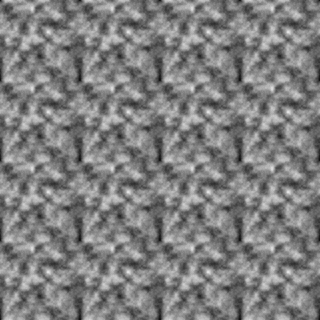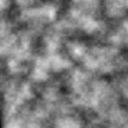Workshop GLSL - Noise - Chapter 8.1 - Perlin Loop

Explanations
Noise sound good. But sometimes we need wrappable textures. So we needs to loop on random table. So let’s add “lp” prefix on loopable function.
#define PROCESSING_COLOR_SHADER
uniform float time;
uniform vec2 resolution;
float rand(vec2 co){
return fract(sin(dot(co.xy ,vec2(12.9898,78.233))) * 43758.5453);
}
float hermite(float t)
{
return t * t * (3.0 - 2.0 * t);
}
Our loopable noise function
float lpnoise(vec2 co, float frequency)
{
vec2 v = co * frequency;
Here we are working modulus frequency
float ix1 = floor(mod(v.x, frequency));
float iy1 = floor(mod(v.y, frequency));
float ix2 = floor(mod(v.x + 1.0, frequency));
float iy2 = floor(mod(v.y + 1.0, frequency));
float fx = hermite(fract(v.x));
float fy = hermite(fract(v.y));
float fade1 = mix(rand(vec2(ix1, iy1)), rand(vec2(ix2, iy1)), fx);
float fade2 = mix(rand(vec2(ix1, iy2)), rand(vec2(ix2, iy2)), fx);
return mix(fade1, fade2, fy);
}
just rename our pnoise function
float lppnoise(vec2 co, float freq, int steps, float persistence)
{
float value = 0.0;
float ampl = 1.0;
float sum = 0.0;
for(int i=0 ; i<steps ; i++)
{
sum += ampl;
value += lpnoise(co, freq) * ampl;
freq *= 2.0;
ampl *= persistence;
}
return value / sum;
}
void main( void ) {
vec2 position = gl_FragCoord.xy / resolution.xy;
try it scaling our vector by 4 to see loop. Traditionnaly we don’t scale it to have just one full loop.
float value = lppnoise(position * 4.0, 10.0, 5, 0.5);
gl_FragColor = vec4(value, value, value,1.0);
}
As expected, we have 16 times the same image and no breaks on edges.
Full Code Source
#define PROCESSING_COLOR_SHADER
uniform float time;
uniform vec2 resolution;
float rand(vec2 co){
return fract(sin(dot(co.xy ,vec2(12.9898,78.233))) * 43758.5453);
}
float hermite(float t)
{
return t * t * (3.0 - 2.0 * t);
}
float lpnoise(vec2 co, float frequency)
{
vec2 v = co * frequency;
float ix1 = floor(mod(v.x, frequency));
float iy1 = floor(mod(v.y, frequency));
float ix2 = floor(mod(v.x + 1.0, frequency));
float iy2 = floor(mod(v.y + 1.0, frequency));
float fx = hermite(fract(v.x));
float fy = hermite(fract(v.y));
float fade1 = mix(rand(vec2(ix1, iy1)), rand(vec2(ix2, iy1)), fx);
float fade2 = mix(rand(vec2(ix1, iy2)), rand(vec2(ix2, iy2)), fx);
return mix(fade1, fade2, fy);
}
float lppnoise(vec2 co, float freq, int steps, float persistence)
{
float value = 0.0;
float ampl = 1.0;
float sum = 0.0;
for(int i=0 ; i<steps ; i++)
{
sum += ampl;
value += lpnoise(co, freq) * ampl;
freq *= 2.0;
ampl *= persistence;
}
return value / sum;
}
void main( void ) {
vec2 position = gl_FragCoord.xy / resolution.xy;
float value = lppnoise(position * 4.0, 10.0, 5, 0.5);
gl_FragColor = vec4(value, value, value,1.0);
}

